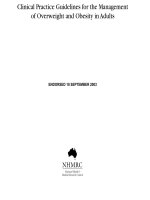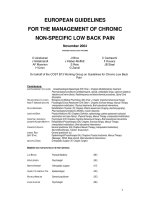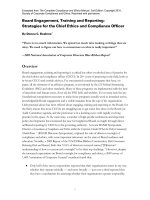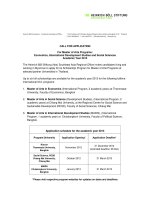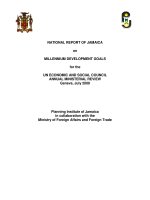Mathematical apprlications for the management life and social sciences
Bạn đang xem bản rút gọn của tài liệu. Xem và tải ngay bản đầy đủ của tài liệu tại đây (11.64 MB, 1,109 trang )
Index of Selected Applications
Management
Accounting, 230
Advertising, 8, 27, 49, 84, 106, 291, 323, 324, 367, 382, 384, 394,
398, 399, 496, 505, 509, 526, 576, 600, 613, 651, 659, 666, 672,
690, 695, 703, 709, 722, 723, 742, 743, 794, 834, 844, 892, 903,
962, 965, 999, 1002
Agricultural business, 287, 292, 304, 307, 319, 326, 329, 345,
353, 401
Airlines, 136, 192
Annual reports, 214
Average cost, 49, 54, 709, 724, 727, 760, 762, 763, 824, 900, 949
Benefits, 540, 989
Break-even analysis, 69, 121, 127, 164, 167, 197, 200
Budgeting, 230, 323
Business risk, 203
Capital investment, 642, 760, 790, 800
Cellular phones, 35, 36, 106, 193, 399, 533, 580, 643, 666, 668, 672,
745, 825
Committees, 508, 511, 529
Company growth, 27, 400, 672, 737
Competition, 258
Competition in telecommunications, 533
Construction, 305, 323, 325, 459
Cost, 83, 84, 119, 126, 133, 135, 136, 151, 160, 169, 176, 181, 182,
183, 199, 212, 275, 335, 392, 393, 615, 629, 642, 676, 686, 687,
688, 689, 813, 845, 846, 849, 852, 866, 903, 920, 927, 943, 949,
956, 971, 997, 999, 1000
Cost-benefit, 54, 83, 96, 100, 107, 197, 595, 601, 613, 642, 650,
755, 756
Customer service, 576, 894, 936
Decision making, 477, 516
Diminishing returns, 711, 715, 722, 723, 760
Egg production, 228
Electrical power use, 182, 614, 951
Employee age and gender, 475, 476, 481, 484, 486
Employee evaluation, 517
Expense accounts, 218
Franchise growth, 835
Fundraising, 138
Hiring, 496, 511, 529
Hospital administration, 137
Hotel pricing, 765
Human resources, 576
Industrial consolidation, 367
Insurance, 424, 446, 517, 540, 552, 553, 556, 563, 572, 574, 576
Interdepartmental costs, 270, 271
Inventory, 249, 476, 571, 737, 740, 744, 761, 763, 903, 986
Job bidding, 486
Job effectiveness, 53
Joint cost, 972, 977
Labor efficiency, 219
Loss, 54
Maintenance costs, 948
Management, 218, 219, 290, 305, 475, 476, 477, 511, 516, 529, 539
Manufacturing, 84, 259, 267, 275, 286, 290, 291, 302, 303, 304,
305, 314, 322, 323, 324, 325, 333, 344, 345, 348, 349, 935,
989, 998
Marginal cost, 120, 126, 135, 136, 673, 675, 676, 681, 772, 775, 783,
812, 963, 972, 977
Marginal profit, 120, 126, 135, 678, 679, 681, 682, 689, 760
Marginal return to sales, 690, 965
Marginal revenue, 615, 630, 631, 647, 674, 680, 681, 689, 709, 775,
780, 783
Market share, 372, 394, 579, 762, 866
Marketing, 476
Minimizing average cost, 727, 733, 734
Minimizing costs, 333, 334, 335, 344, 345, 348, 349, 351, 691, 738,
744, 745, 756, 760, 763, 764
Oil refineries, 229
Operating leverage, 203
Organizational growth, 388, 393, 394
Package design, 36, 84, 181, 739, 763, 764
Parking costs, 601
Parts delivery, 485
Parts listings, 267, 272
Postal rates, 182, 614
Pricing, 90, 117, 118, 228, 658, 709, 765, 862, 1003
Pricing for maximum profit, 57
Printing, 761
Product design, 761
Product display, 511
Product reliability, 367, 392, 551, 834, 890, 894
Production, 219, 228, 230, 235, 272, 274, 275, 344, 349, 665, 709,
723, 790, 795, 834, 868, 872, 893, 944, 955, 958, 961, 971, 973,
978, 988, 989, 994, 997, 999, 1000, 1001
Production costs, 220, 222, 277, 298, 304, 348, 709, 743, 750, 764
Productivity, 528, 600, 612, 630, 642, 665, 687, 709, 722, 743, 756,
760, 761, 834, 866
Profit, 35, 54, 64, 70, 83, 84, 119, 121, 126, 134, 135, 136, 149, 150,
159, 196, 244, 280, 393, 411, 600, 630, 678, 679, 687, 688, 711,
715, 743, 756, 800, 813, 866, 867, 903, 961, 971, 988, 989,
1000, 1001
Profit maximization, 57, 154, 166, 168, 197, 200, 292, 303, 305, 306,
307, 314, 323, 324, 325, 336, 340, 344, 348, 349, 350, 351, 353,
426, 683, 686, 729, 734, 753, 760, 761, 762, 765, 848, 849, 852,
979, 983
Project teams, 509
Property development, 482, 741, 945
Publicity, 576
Purchasing, 70, 329
Purchasing electric power, 951
Quality control, 472, 476, 477, 491, 495, 496, 499, 513, 516, 517, 528,
529, 538, 539, 540, 563, 564, 571, 576, 579, 936, 948, 949
Rentals, 35, 70, 117, 118, 160, 244, 447, 475, 484, 496, 530
Revenue, 35, 42, 54, 84, 85, 119, 126, 135, 158, 160, 199, 228, 387,
393, 562, 576, 579, 600, 620, 629, 639, 641, 642, 650, 651, 658,
661, 663, 665, 671, 672, 674, 686, 687, 688, 689, 710, 743, 745,
756, 760, 812, 813, 818, 821, 824, 831, 834, 843, 849, 866,
949, 997
Revenue maximization, 156, 197, 295, 325, 345, 724, 725, 733, 761,
763, 765
Rewards for employees, 515
Safety, 192, 478, 801, 812
Salaries, 70, 411, 412, 459, 484, 551, 552
Sales, 217, 456, 511, 516, 552, 563, 600, 612, 613, 756, 862
Sales decay, 382, 384, 391, 392, 398, 399, 782, 813
Sales growth, 390, 393, 394, 398
Sales promotion, 475
Scheduling, 290, 303, 304, 323, 333, 334, 335, 336, 340, 344
Shadow prices, 304, 319, 353
Shipping, 305, 323
Starbucks stores, 401
Telecommunications, 399, 581, 881, 893, 915, 918
Ticket sales, 244
Time study, 49
Transportation, 27, 245, 252, 258, 259, 276, 352
Unions, 161, 218, 666
Utilities, 94, 95, 178, 182, 197, 529, 601, 625
Warranties, 936
Wilson’s lot size formula, 960, 971
Wireless service spending, 71, 882, 893
Economics
Balance of trade, 206, 210, 217
Budget deficit, 193
Cobb-Douglas production function, 955, 958, 961, 974, 978, 994, 995,
997, 1001
Competitive market, 975
Competitive products, 976, 1003
Complementary products, 976
Consumer expenditure, 41, 106, 117, 630, 743, 1001
Consumer price index, 36, 95, 188, 364, 368, 710, 723, 785, 825, 845
Consumer’s surplus, 908, 909, 912, 914, 915, 920, 948
Continuous income streams, 883, 889, 893, 904, 905, 913, 914, 920,
921, 924, 927, 943, 948, 949
Demand, 122, 128, 135, 136, 161, 162, 163, 167, 182, 197, 199, 387,
392, 393, 569, 612, 629, 642, 653, 657, 659, 665, 687, 776, 785,
792, 795, 800, 813, 869, 903, 943, 944, 975, 979, 1001
Dow Jones averages, 7, 19, 73, 82, 601, 736
Economy models, 260, 266, 276, 278
Elasticity of demand, 802, 803, 804, 805, 809, 812, 813
Employment, 496
Gasoline mileage and prices, 552, 571
Gini coefficient of income, 895, 899, 904, 927, 944, 950
Gompertz curves, 382, 393, 398, 863
Gross domestic product, 182, 192, 643, 660, 724, 863
Income distribution, 894, 899, 904, 927, 944, 948, 950
Indifference curves, 958, 961
Inflation, 362, 392, 397, 426, 812, 814, 836, 837, 864
Job growth, 7
Leontief input-output models, 260, 261, 262, 263, 264, 266, 269, 270,
271, 272, 276, 278
Lorenz curves, 894, 904, 927, 944, 950
Marginal demand, 976, 1000
Marginal productivity, 973, 974
Marginal return to sales, 690, 965
Marginal utility, 971
Market equilibrium, 123, 124, 128, 135, 161, 162, 163, 167, 197, 199
Market equilibrium after taxes, 125, 130
Monopoly market, 910
National consumption, 665, 850, 851, 853, 866, 867
National debt, 368, 392, 614, 763, 783
Oil imports, 881, 894, 950
Open and closed economies, 264, 266, 269, 271, 278
Optimization in business, 691
Personal income, 14, 19, 368, 399, 631, 637, 784, 825, 845
Producer’s surplus, 911, 912, 915, 920, 927, 948, 949
Purchasing power, 362, 364, 392, 393, 784, 813
Social Security benefits, 82, 141, 146, 149, 399
Supply, 122, 128, 135, 136, 161, 162, 163, 167, 197, 199, 392, 393,
687, 775, 800, 869, 944
Taxation, 15, 70, 71, 73, 76, 94, 107, 125, 130, 150, 182, 183, 186,
193, 279, 601, 602, 606, 613, 660, 761, 808, 810, 812, 813,
904, 1000
Tourism spending, 150, 181, 399, 635, 784, 882, 927
Unemployment, 550
Utility, 958, 961, 971, 990, 993, 997, 999, 1000, 1001
Work force, 83, 101, 106, 161, 207, 381, 485, 616, 652, 686, 724, 756,
776, 815, 835
Finance
Amortization, 449, 450, 454, 455, 456, 457, 458, 460, 461, 959
Annuities, 49, 427, 428, 429, 430, 431, 434, 435, 436, 437, 438, 439,
440, 445, 446, 447, 448, 459, 460, 613
Annuities due, 433, 435, 442, 443, 446
APY, 418, 424, 459, 461
ATM transactions, 515
Banks, 85, 91, 305, 511, 516
Bond pricing, 440
Bonds, 441, 446, 447, 460, 461, 462, 552
Budgeting, 323, 563
Capital value, 929, 935, 949
College savings, 412, 414, 418, 423, 424, 435, 436, 448, 459, 461, 462
Compound interest, 19, 33, 367, 368, 393, 398, 412, 414, 415, 417,
423, 458, 459, 460, 461, 462, 777, 779, 811, 812, 844, 861
Consumer credit, 397
Court settlements, 443, 447, 461
CPA exam, 564
Credit cards, 69, 517, 518
Debt, 218, 450, 454, 455, 458, 461
Debt refinancing, 82
Deferred annuities, 444, 448
Delinquent accounts, 486, 490
Depreciation, 69, 86, 94, 95, 136, 426, 892
Doubling time, 371, 381, 419
Earnings, 660, 709
Future value, 53, 458
Future value of annuities, 427, 428, 429, 430, 431, 434, 435, 436, 459
Future value of income stream, 907, 914
Future value of investments, 33, 53, 62, 357, 359, 367, 393, 398, 410,
414, 423, 424, 425, 459, 460, 782, 959
Home equity loans, 463
Income levels, 529
Income stream, 913, 914, 920, 921, 924, 927, 943, 948, 949
Investing, 26, 33, 35, 41, 62, 65, 70, 110, 118, 134, 136, 239, 244,
245, 246, 259, 275, 277, 278, 325, 357, 359, 367, 368, 369, 371,
381, 393, 398, 404, 405, 410, 415, 417, 419, 423, 424, 425, 435,
436, 446, 459, 460, 462, 659, 775, 862, 866, 959
Loans, 53, 82, 118, 244, 410, 411, 450, 453, 454, 455, 456, 457, 458,
459, 460, 463, 1001
Mortgages, 76, 81, 133, 449, 450, 456, 457, 462, 464, 960, 970
Mutual funds, 394, 516
Net worth, 579
Perpetuities, 613
Personal income, 19
Present value, 19, 410, 458, 906, 914, 927, 943
Present value of annuities, 437, 438, 445, 446, 448
Purchasing a home, 464
Real estate, 117, 551, 836, 837
Retirement planning, 95, 160, 424, 425, 435, 436, 446, 447, 448, 461,
462, 951, 989, 999
Savings, 410, 425, 435, 436, 448, 459, 460, 948, 999
Simple interest, 41, 404, 405, 410, 411, 458, 459, 460, 461
Sinking funds, 431, 435, 436, 459
Stock market, 5, 7, 19, 368, 393, 410, 415, 424, 425, 460, 529,
601, 813
Taxes, 15, 70, 71, 73, 94, 107, 124, 130, 279, 280, 601, 602, 606, 613,
660, 904
NINTH EDITION
Mathematical
Applications
for the Management, Life, and Social Sciences
This page intentionally left blank
NINTH EDITION
Mathematical
Applications
for the Management, Life, and Social Sciences
Ronald J. Harshbarger
University of South Carolina Beaufort
James J. Reynolds
Clarion University of Pennsylvania
University of South Carolina Beaufort
Australia • Brazil • Japan • Korea • Mexico • Singapore • Spain • United Kingdom • United States
Senior Sponsoring Editor: Cathy Cantin
Associate Editor: Jeannine Lawless
Media Editor: Catie Ronquillo
Marketing Specialist: Ashley Pickering
Marketing Communications Manager: Mary
Anne Payumo
Project Manager, Editorial Production: Shelley
Dickerson
Art and Design Manager: Jill Haber
Senior Content Manager: Maren Kunert
Manufacturing Buyer: Diane Gibbons
Permissions Editor: Craig Mertens
Text Designer: Jean Hammond
Photo Manager: Jennifer Meyer Dare
Photo Researcher: Stacey Dong
Cover Designer: Anne Katzeff
Cover Image: © Stuttgart Pforzheim/Getty Images
Compositor: Aptara®, Inc.
Photo Credits: p. 1, Gail Shumway/Getty Images; p. 58, © Natalie Behring/Digital Railroad;
p. 139, © Patrick Brice/Arcaid/Corbis; p. 201, NASA; p. 204, © Klaus Leidorf/zefa/Corbis;
p. 281, © Wang Hoof/epa/Corbis; p. 355, © Roy Botterell/Corbis; p. 402, Ted Russell/Getty
Images; p. 465, © Mike Denton/Alamy; p. 534, © Darell Gulin/CORBIS; p. 584, Al Bello/Getty
Images; p. 693, © Nakheel Corporation; p. 766, © Pat Bennett/Alamy; p. 816, © John Edward
Linden/Arcaid/Corbis; p. 870, © 2008 Jupiterimages Corporation; p. 953, © PCL/Alamy
© 2009 Brooks Cole, Cengage Learning
ALL RIGHTS RESERVED. No part of this work covered by the copyright herein may be reproduced,
transmitted, stored, or used in any form or by any means graphic, electronic, or mechanical, including
but not limited to photocopying, recording, scanning, digitizing, taping, Web distribution, information
networks, or information storage and retrieval systems, except as permitted under Section 107 or 108
or the 1976 United States Copyright Act, without the prior written permission of the publisher.
For product information and technology assistance, contact us at
Cengage Learning Academic Resource Center, 1-800-423-0563
For permission to use material from this text or product,
submit all requests online at www.cengage.com/permissions.
Further permissions questions can be e-mailed to
Library of Congress Control Number: 2008921465
ISBN-13: 978-0-547-14509-9
ISBN-10: 0-547-14509-8
Brooks/Cole
10 Davis Drive
Belmont, CA 94002
USA
Cengage Learning products are represented in Canada by Nelson Education, Ltd.
For your course and learning solutions, visit
academic.cengage.com.
Purchase any of our products at your local college store
or at our preferred online store www.ichapters.com.
Printed in the United States of America
1 2 3 4 5 6 7 12 11 10 09 08
Contents
Preface
0
Algebraic Concepts
xii
1
0.1
Sets 2
0.2
The Real Numbers 9
0.3
Integral Exponents 15
0.4
Radicals and Rational Exponents 20
0.5
Operations with Algebraic Expressions 27
0.6
Factoring 37
0.7
Algebraic Fractions 42
Key Terms and Formulas 49
Review Exercises 51
Chapter Test 54
Extended Applications & Group Projects 56
Campaign Management • Pricing for Maximum Profit
1
Linear Equations and Functions
58
Warm-up 59
1.1
Solution of Linear Equations and Inequalities in One Variable 60
1.2
Functions 71
1.3
Linear Functions 85
1.4
Graphs and Graphing Utilities 96
Graphical Solutions of Equations
1.5
Solutions of Systems of Linear Equations 107
Three Equations in Three Variables
1.6
Applications of Functions in Business and Economics 119
Total Cost, Total Revenue, and Profit • Break-Even Analysis • Supply, Demand, and
Market Equilibrium
Key Terms and Formulas 130
Review Exercises 132
Chapter Test 135
Extended Applications & Group Projects 137
Hospital Administration • Fundraising
v
vi
● Contents
2
Quadratic and Other Special Functions
139
Warm-up 140
2.1
Quadratic Equations 141
Factoring Methods • The Quadratic Formula
2.2
Quadratic Functions: Parabolas 151
2.3
Business Applications of Quadratic Functions 161
Supply, Demand, and Market Equilibrium • Break-Even Points and Maximization
2.4
Special Functions and Their Graphs 169
Polynomial and Rational Functions • Piecewise Defined Functions
2.5
Modeling; Fitting Curves to Data with Graphing Utilities (optional) 183
Key Terms and Formulas 194
Review Exercises 195
Chapter Test 198
Extended Applications & Group Projects 201
An Inconvenient Truth • Body-Mass Index • Operating Leverage and Business Risk
3
Matrices
204
Warm-up 205
3.1
Matrices 206
3.2
Multiplication of Matrices 220
3.3
Gauss-Jordan Elimination: Solving Systems of Equations 230
Systems with Unique Solutions • Systems with Nonunique Solutions
3.4
Inverse of a Square Matrix; Matrix Equations 246
Matrix Equations • Determinants
3.5
Applications of Matrices: Leontief Input-Output Models 260
Key Terms and Formulas 273
Review Exercises 273
Chapter Test 276
Extended Applications & Group Projects 279
Taxation • Company Profits After Bonuses and Taxes
4
Inequalities and Linear Programming
281
Warm-up 282
4.1
Linear Inequalities in Two Variables 283
4.2
Linear Programming: Graphical Methods 292
4.3
The Simplex Method: Maximization 306
Nonunique Solutions: Multiple Solutions and No Solution • Shadow Prices
4.4
The Simplex Method: Duality and Minimization 326
4.5
The Simplex Method with Mixed Constraints 336
Contents ●
vii
Key Terms 345
Review Exercises 346
Chapter Test 350
Extended Applications & Group Projects 352
Transportation • Slack Variables and Shadow Prices
5
Exponential and Logarithmic Functions
355
Warm-up 356
5.1
Exponential Functions 357
Modeling with Exponential Functions
5.2
Logarithmic Functions and Their Properties 369
Logarithmic Functions and Graphs • Modeling with Logarithmic Functions •
Properties of Logarithms • Change of Base
5.3
Solution of Exponential Equations: Applications of Exponential and Logarithmic
Functions 382
Solving Exponential Equations Using Logarithmic Properties • Growth and Decay •
Economic and Management Applications • Gompertz Curves and Logistic Functions
Key Terms and Formulas 395
Review Exercises 396
Chapter Test 398
Extended Applications & Group Projects 400
Starbucks Stores • Agricultural Business Management
6
Mathematics of Finance
402
Warm-up 403
6.1
Simple Interest; Sequences 404
Simple Interest • Sequences • Arithmetic Sequences
6.2
Compound Interest; Geometric Sequences 412
Compound Interest • Geometric Sequences
6.3
Future Value of Annuities 427
Ordinary Annuities • Annuities Due
6.4
Present Values of Annuities 437
Ordinary Annuities • Annuities Due • Deferred Annuities
6.5
Loans and Amortization 449
Unpaid Balance of a Loan
Key Terms and Formulas 457
Review Exercises 458
Chapter Test 461
Extended Applications & Group Projects 463
Mail Solicitation Home Equity Loan: Is This a Good Deal? • Profit Reinvestment •
Purchasing a Home
viii
● Contents
7
Introduction to Probability 465
Warm-up 466
7.1
Probability; Odds 467
7.2
Unions and Intersections of Events: One-Trial Experiments 478
7.3
Conditional Probability: The Product Rule 486
7.4
Probability Trees and Bayes’ Formula 497
Probability Trees • Bayes’ Formula
7.5
Counting: Permutations and Combinations 505
7.6
Permutations, Combinations, and Probability 512
7.7
Markov Chains 517
Key Terms and Formulas 526
Review Exercises 527
Chapter Test 530
Extended Applications & Group Projects 532
Phone Numbers • Competition in the Telecommunications Industry
8
Further Topics in Probability; Data Description
534
Warm-up 535
8.1
Binomial Probability Experiments 536
8.2
Data Description 540
8.3
Discrete Probability Distributions; The Binomial Distribution 553
Discrete Probability Distributions • Measures of Dispersion • The Binomial
Distribution
8.4
Normal Probability Distribution 564
8.5
The Normal Curve Approximation to the Binomial Distribution 572
Key Terms and Formulas 577
Review Exercises 578
Chapter Test 580
Extended Applications & Group Projects 582
Lotteries • Statistics in Medical Research; Hypothesis Testing
9
Derivatives
584
Warm-up 585
9.1
Limits 586
9.2
Continuous Functions; Limits at Infinity 602
Summary
9.3
Average and Instantaneous Rates of Change: The Derivative
9.4
Derivative Formulas 631
9.5
The Product Rule and the Quotient Rule 644
9.6
The Chain Rule and the Power Rule 653
9.7
Using Derivative Formulas 661
615
Contents ●
9.8
Higher-Order Derivatives 666
9.9
Applications of Derivatives in Business and Economics 673
Key Terms and Formulas 683
Review Exercises 684
Chapter Test 688
Extended Applications & Group Projects 690
Marginal Return to Sales • Tangent Lines and Optimization in Business
and Economics
10 Applications of Derivatives
693
Warm-up 694
10.1 Relative Maxima and Minima: Curve Sketching 695
10.2 Concavity: Points of Inflection 711
Second-Derivative Test
10.3 Optimization in Business and Economics 724
Maximizing Revenue • Minimizing Average Cost • Maximizing Profit
10.4 Applications of Maxima and Minima 737
10.5 Rational Functions: More Curve Sketching 745
Asymptotes • More Curve Sketching
Key Terms and Formulas 757
Review Exercises 758
Chapter Test 762
Extended Applications & Group Projects 764
Production Management • Room Pricing in the Off-Season
11 Derivatives Continued
766
Warm-up 767
11.1 Derivatives of Logarithmic Functions 768
11.2 Derivatives of Exponential Functions 777
11.3 Implicit Differentiation 785
11.4 Related Rates 795
11.5 Applications in Business and Economics 802
Elasticity of Demand • Taxation in a Competitive Market
Key Terms and Formulas 810
Review Exercises 811
Chapter Test 813
Extended Applications & Group Projects 814
Inflation • Knowledge Workers
ix
x
● Contents
12 Indefinite Integrals
816
Warm-up 817
12.1 The Indefinite Integral 818
12.2 The Power Rule 826
12.3 Integrals Involving Exponential and Logarithmic Functions 836
12.4 Applications of the Indefinite Integral in Business and Economics 845
Total Cost and Profit • National Consumption and Savings
12.5 Differential Equations 854
Separable Differential Equations • Applications of Differential Equations
Key Terms and Formulas 864
Review Exercises 865
Chapter Test 867
Extended Applications & Group Projects 868
Employee Production Rate • Supply and Demand
13 Definite Integrals: Techniques of Integration
870
Warm-up 871
13.1 Area Under a Curve 872
13.2 The Definite Integral: The Fundamental Theorem of Calculus 883
13.3 Area Between Two Curves 894
13.4 Applications of Definite Integrals in Business and Economics 904
Continuous Income Streams • Consumer’s Surplus • Producer’s Surplus
13.5 Using Tables of Integrals 915
13.6 Integration by Parts 921
13.7 Improper Integrals and Their Applications 927
13.8 Numerical Integration Methods: Trapezoidal Rule and Simpson’s Rule 936
Key Terms and Formulas 945
Review Exercises 947
Chapter Test 949
Extended Applications & Group Projects 951
Retirement Planning • Purchasing Electrical Power
Contents ●
14 Functions of Two or More Variables
xi
953
Warm-up 954
14.1 Functions of Two or More Variables 955
14.2 Partial Differentiation 962
First-Order Partial Derivatives • Higher-Order Partial Derivatives
14.3 Applications of Functions of Two Variables in Business and Economics 972
Joint Cost and Marginal Cost • Production Functions • Demand Functions
14.4 Maxima and Minima 979
Linear Regression
14.5 Maxima and Minima of Functions Subject to Constraints: Lagrange Multipliers 990
Key Terms and Formulas 998
Review Exercises 999
Chapter Test 1001
Extended Applications & Group Projects 1002
Advertising • Competitive Pricing
Appendix AP-1
Table I: Future Value of an Ordinary Annuity of $1 (sn0i) AP-1
Table II: Present Value of an Ordinary Annuity of $1 (an0i) AP-3
Table III: Areas Under the Standard Normal Curve AP-5
Answers A-1
Index I-1
Preface
T
o paraphrase English mathematician, philosopher, and educator Alfred North Whitehead, the purpose of education is not to fill a vessel but to kindle a fire. In particular,
Whitehead encouraged students to be creative and imaginative in their learning and
to continually form ideas into new and more exciting combinations. This desirable goal is
not always an easy one to realize in mathematics with students whose primary interests are
in areas other than mathematics. The purpose of this text, then, is to present mathematical
skills and concepts, and to apply them to ideas that are important to students in the management, life, and social sciences. We hope that this look at the relevance of mathematical
ideas to a broad range of fields will help inspire the imaginative thinking and excitement
for learning that Whitehead spoke of. The applications included allow students to view
mathematics in a practical setting relevant to their intended careers. Almost every chapter
of this book includes a section or two devoted to the applications of mathematical topics,
and every section contains a number of application examples and problems. An index of
these applications on the front and back inside covers demonstrates the wide variety used
in examples and exercises. Although intended for students who have completed two years
of high school algebra or its equivalent, this text begins with a brief review of algebra which,
if covered, will aid in preparing students for the work ahead.
Pedagogical Features
In this new edition, we have incorporated many suggestions that reflect the needs and wishes
of our users. Important pedagogical features that have characterized previous editions have
been retained. They are as follows.
Intuitive Viewpoint. The book is written from an intuitive viewpoint, with emphasis on
concepts and problem solving rather than on mathematical theory. Yet each topic is carefully developed and explained, and examples illustrate the techniques involved.
Flexibility. At different colleges and universities, the coverage and sequencing of topics
may vary according to the purpose of the course and the nature of the student audience. To
accommodate alternate approaches, the text has a great deal of flexibility in the order in
which topics may be presented and the degree to which they may be emphasized.
Chapter Warm-ups. With the exception of Chapter 0, a Warm-up appears at the beginning
of each chapter and invites students to test themselves on the skills needed for that chapter. The Warm-ups present several prerequisite problem types that are keyed to the appropriate sections in the upcoming chapter where those skills are needed. Students who have
difficulty with any particular skill are directed to specific sections of the text for review.
Instructors may also find the Warm-ups useful in creating a course syllabus that includes
an appropriate scope and sequence of topics.
Application Previews. Each section begins with an Application Preview that establishes
the context and direction for the concepts that will be presented. Each of these Previews
contains an example that motivates the mathematics in the section and is then revisited in
a completely worked Application Preview example appearing later in the section.
Comprehensive Exercise Sets. The overall variety and grading of drill and application exercises offer problems for different skill levels, and there are enough challenging problems to
stimulate students in thoughtful investigations. Many exercise sets contain critical thinking
and thought-provoking multistep problems that extend students’ knowledge and skills.
xii
Preface ●
xiii
Applications. We have found that integrating applied topics into the discussions and exercises helps provide motivation within the sections and demonstrates the relevance of each
topic. Numerous real-life application examples and exercises represent the applicability of
the mathematics, and each application problem is identified, so the instructor or student can
select applications that are of special interest. In addition, we have found that offering
separate lessons on applied topics such as cost, revenue, and profit functions brings the preceding mathematical discussions into clear, concise focus and provides a thread of continuity as mathematical sophistication increases. There are ten such sections in the book, and
entire chapters devoted to linear programming and financial applications. Of the more than
5,500 exercises in the book, over 2,000 are applied.
Extended Applications and Group Projects. Each chapter ends with at least two of these
32 case studies, which further illustrate how mathematics can be used in business and personal decision making. In addition, many applications are cumulative in that solutions
require students to combine the mathematical concepts and techniques they learned in some
of the preceding chapters.
Graphical, Numerical, and Symbolic Methods. A large number of real data and modeling
applications are included in the examples and exercises throughout the text and are denoted
by the header Modeling. Many sections include problems with functions that are modeled
from real data and some problems that ask students to model functions from the data given.
These problems are solved by using one or more graphical, numerical, or symbolic methods.
Graphing Utilities and Spreadsheets. In the Ninth Edition, we have increased the overall
presence of our treatment of graphing utilities and especially spreadsheets. More examples,
applications, Technology Notes, Calculator Notes, and Spreadsheet Notes, denoted by the icon
, are scattered throughout the text. After the introduction to Excel in Section 0.5 and to graphing calculators in Section 1.4, discussions of the use of technology are placed in subsections
and examples in many sections, so that they can be emphasized or de-emphasized at the option
of the instructor.
The discussions of graphing utility technology highlight its most common features and
uses, such as graphing, window setting, trace, zoom, Solver, tables, finding points of intersection, numerical derivatives, numerical integration, matrices, solving inequalities, and modeling (curve fitting). While technology never replaces the mathematics, it does supplement and
extend it by providing opportunities for generalization and alternative ways of understanding,
doing, and checking. Some exercises that are better worked with the use of technology, including graphing calculators, computer programs, and computer spreadsheets, are highlighted with
the technology icon. Of course, many additional exercises can benefit from the use of technology, at the option of the instructor. Technology can be used to graph functions and to
discuss the generalizations, applications, and implications of problems being studied.
In addition, the basics of spreadsheet operations are introduced and opportunities to
solve problems with spreadsheets are provided. The Ninth Edition now includes more Excel
information specifically relating to solving equations, systems of equations, quadratic equations, matrices, linear programming, output comparisons of f(x), fЈ(x), and f Љ(x), and the
maxima and minima of functions subject to constraints. Excel is also a particularly useful
problem-solving tool when studying the Mathematics of Finance in Chapter 6. A separate
Excel Guide offering examples and user information is available for purchase. Please see
the Resources for the Student section on page xv of this Preface for more information.
Checkpoints. The Checkpoints ask questions and pose problems within each section’s
discussion, allowing students to check their understanding of the skills and concepts under
discussion before they proceed. Solutions to these Checkpoints appear before the section
exercises.
Objective Lists. Every section begins with a brief list of objectives that outline the goals
of that section for the student.
xiv
● Preface
Procedure/Example and Property/Example Tables. Appearing throughout the text, these
tables aid student understanding by giving step-by-step descriptions of important procedures
and properties with illustrative examples worked out beside them.
Boxed Information. All important information is boxed for easy reference, and key terms
are highlighted in boldface.
Key Terms and Formulas. At the end of each chapter, just before the Chapter Review
Exercises, there is a section-by-section listing of that chapter’s key terms and formulas. This
provides a well-organized core from which a student can build a review, both to consult
while working the Review Exercises and to identify quickly any section needing additional
study.
Review Exercises and Chapter Tests. At the end of each chapter, a set of Review Exercises
offers students extra practice on topics in that chapter. These Reviews cover each chapter’s
topics primarily in their section order, but without section references, so that students get a
true review but can readily find a section for further review if difficulties occur. A Chapter
Test follows each set of Review Exercises. All Chapter Tests provide a mixture of problems
that do not directly mirror the order of topics found within the chapter. This organization
of the Chapter Test ensures that students have a firm grasp of all material in the chapter.
Changes in the Ninth Edition
In the Ninth Edition, we continue to offer a text characterized by complete and accurate
pedagogy, mathematical precision, excellent exercise sets, numerous and varied applications,
and student-friendly exposition. There are many changes in the mathematics, prose, and art.
The more significant ones are as follows.
■
A new section, “Normal Approximation to the Binomial,” which discusses binomial
probability applications involving large numbers of trials, has been added.
■
Three new Extended Applications/Group Projects have been added, two in Chapter 2
and one in Chapter 5. The two added in Chapter 2, “An Inconvenient Truth” and
“Body Mass Index,” address important health, environmental, and economic issues.
The “Inconvenient Truth” project is based on and utilizes Al Gore’s Oscar-winning
film of the same title to investigate some of the mathematics behind Gore’s Nobel
Peace Prize-winning work on global warming.
■
Extended Applications/Group Projects have been updated as appropriate. These include
Hospital Administration in Chapter 1, Phone Area Code Numbers in Chapter 7, and
Powerball Lotteries in Chapter 8.
■
Expanded applications of matrix inverses explore the sensitivity of solutions in applications of systems of linear equations and in Input-Output models.
■
Drill Exercises throughout the text have been revised and reorganized to improve
their grading and variety.
■
Solution of exponential and logarithmic equations (in Chapter 5) boasts expanded
exposition, additional examples, and more comprehensive drill exercises.
■
Bond Pricing has been added to Section 6.4, Present Values of Annuities. This new
application utilizes calculations of simple interest and present values of both compound interest investments and ordinary annuities and combines these to determine
market prices for bonds.
■
Exercise Sets for Mathematics of Finance in Chapter 6 have been reorganized and
revised to provide adequate drills as well as to expand the sets of problems that
include miscellaneous finance applications.
Preface ●
xv
■
The section reference labels have been removed from the Chapter Review Exercises
throughout the text. This improves the effectiveness of these exercises because students now must establish a context for each problem as well as solve it.
■
Data-driven and modeling examples and exercises have been updated or replaced
with current applications.
■
An increased number of optional Excel discussions have been inserted where
appropriate.
Resources for the Student
Student Solutions Manual. Need a leg up on your homework or help to prepare for an exam?
The Student Solutions Manual contains worked-out solutions for all odd-numbered exercises
in the text. It is a great resource to help you understand how to solve those tough problems.
Microsoft Excel Guide. This guide provides a list of exercises from the text that can be
completed after each step-by-step Excel example. No prior knowledge of Excel is necessary.
WebAssign. WebAssign, the most widely used homework system in higher education,
offers instant feedback and repeatable problems—everything you could ask for in an online
homework system. WebAssign’s homework system lets you practice and submit homework
via the web. It is easy to use and loaded with extra resources. With this edition of Mathematical Applications for the Management, Life, and Social Sciences there are over 1,500
algorithmic homework exercises to use for practice and review.
DVD Lecture Series. Comprehensive, instructional lecture presentations serve a number
of uses. They are great if you need to catch up after missing a class, need to supplement
online or hybrid instruction, or need material for self-study or review.
Resources for the Instructor
WebAssign. Instant feedback, grading precision, and ease of use are just three reasons why
WebAssign is the most widely used homework system in higher education. WebAssign’s
homework delivery system lets instructors deliver, collect, grade, and record assignments
via the web. With this edition of Mathematical Applications for the Management, Life, and
Social Sciences there are over 1,500 algorithmic homework exercises to choose from. These
algorithmic exercises are based on the section exercises from the textbook to ensure
alignment with course goals.
Instructor’s Complete Solutions Manual. The Instructor’s Complete Solutions Manual
contains worked solutions for all exercises in the text. It also contains solutions to the special
features in the text such as the Extended Applications and Group Projects. It is available at
the Instructor’s Resource Center on the book’s website.
Power Lecture. This comprehensive CD-ROM includes the Instructor’s Solutions Manual,
PowerPoint slides, and the computerized test bank featuring algorithmically created questions to create, deliver, and customize tests.
Computerized Test Bank. Create, deliver, and customize tests and study guides in minutes with this easy-to-use assessment software on CD. The thousands of algorithmic questions in the test bank are derived from the textbook exercises, ensuring consistency between
exams and the book.
JoinIn on TurningPoint. Enhance how your students interact with you, your lecture, and
each other. Cengage Learning is now pleased to offer you book-specific content for
Response Systems tailored to Mathematical Applications for the Management, Life, and
Social Sciences, allowing you to transform your classroom and assess your students’
progress with instant in-class quizzes and polls.
xvi
● Preface
Acknowledgments
We would like to thank the many people who helped us at various stages of revising this
text. The encouragement, criticism, contributions, and suggestions that were offered were
invaluable to us. Special thanks go to Victoria Sapko of Framingham State College for her
contribution to the Inconvenient Truth Extended Application. We are also especially grateful to Dave Hipfel for his insights regarding bond pricing and his help with application
exercises and Extended Applications.
Once again we have been fortunate to have Helen Medley’s assistance with accuracy
checking of the entire text and answer section during manuscript preparation and on the
page proofs. As always, we continue to be impressed by and most appreciative of her work
ethic, attention to detail, accuracy, and skill.
For their reviews of draft manuscript and the many helpful comments that were offered,
we would like to thank
Jerry Allison
Joy Beverly
Elsie Campbell
Vladimir Fomichov
Mallie Hood
Lance Lana
Gabriel Mendoza
Sam Obeid
Elaine Russell
Catherine Stanley
Margaret Jeanne Trubek
Dr. Henry L. Wyzinski
Black Hawk College
University of Miami
Angelo State University
Southern New Hampshire University
Paris Junior College
University of Colorado DHSC
El Paso Community College
Richland College
Angelina College
Acadia University
Emmanuel College
Indiana University Northwest
Ronald J. Harshbarger
James J. Reynolds
0
Algebraic Concepts
This chapter provides a brief review of the algebraic
concepts that will be used throughout the text. You may
be familiar with these topics, but it may be helpful to
spend some time reviewing them. In addition, each chapter
after this one opens with a warm-up page that identifies
prerequisite skills needed for that chapter. If algebraic
skills are required, the warm-up cites their coverage in this
chapter. Thus you will find that this chapter is a useful
reference as you study later chapters.
The topics and applications studied in this chapter
include the following.
Sections
Applications
0.1 Sets
Set operations
Venn diagrams
Dow Jones Average,
jobs growth
0.2 The Real Numbers
Inequalities and intervals
Absolute value
Income taxes, health
statistics
0.3 Integral Exponents
Personal income,
endangered species
0.4 Radicals and Rational
Exponents
Roots and fractional exponents
Operations with radicals
Richter scale, half-life
0.5 Operations with Algebraic
Expressions
Revenue, profit
0.6 Factoring
Common factors
Factoring trinomials
Simple interest, revenue
0.7 Algebraic Fractions
Operations
Complex fractions
Average cost, advertising
and sales
2
● Chapter 0
Algebraic Concepts
0.1
Sets
A set is a well-defined collection of objects. We may talk about a set of books, a set of
dishes, a set of students, or a set of individuals with a certain blood type. There are two
ways to tell what a given set contains. One way is by listing the elements (or members)
of the set (usually between braces). We may say that a set A contains 1, 2, 3, and 4 by writing A ϭ 51, 2, 3, 46. To say that 4 is a member of set A, we write 4 ʦ A. Similarly, we
write 5 A to denote that 5 is not a member of set A.
If all the members of the set can be listed, the set is said to be a finite set. A ϭ
51, 2, 3, 46 and B ϭ 5x, y, z6 are examples of finite sets. When we do not wish to list all the
elements of a finite set, we can use three dots to indicate the unlisted members of the set.
For example, the set of even integers from 8 to 8952, inclusive, could be written as
58, 10, 12, 14, . . . , 89526
For an infinite set, we cannot list all the elements, so we use the three dots. For example,
N ϭ 51, 2, 3, 4, . . .6 is an infinite set. This set N is called the set of natural numbers.
Another way to specify the elements of a given set is by description. For example, we
may write D ϭ 5x: x is a Ford automobile6 to describe the set of all Ford automobiles. Furthermore, F ϭ 5y: y is an odd natural number6 is read “F is the set of all y such that y is an
odd natural number.”
● EXAMPLE 1 Describing Sets
Write the following sets in two ways.
(a) The set A of natural numbers less than 6
(b) The set B of natural numbers greater than 10
(c) The set C containing only 3
Solution
(a) A ϭ 51, 2, 3, 4, 56 or A ϭ 5x: x is a natural number less than 66
(b) B ϭ 511, 12, 13, 14, . . .6 or B ϭ 5x: x is a natural number greater than 106
(c) C ϭ 536 or C ϭ 5x: x ϭ 36
Note that set C of Example 1 contains one member, 3; set A contains five members;
and set B contains an infinite number of members. It is possible for a set to contain no
members. Such a set is called the empty set or the null set, and it is denoted by л or by
{ }. The set of living veterans of the War of 1812 is empty because there are no living
veterans of that war. Thus
5x: x is a living veteran of the War of 18126 ϭ л
Special relations that may exist between two sets are defined as follows.
Relations Between Sets
Definition
1. Sets X and Y are equal if they contain the same
elements.
2. A is called a subset of B, which is written A ʕ B, if
every element of A is an element of B. The empty set
is a subset of every set. Each set A is a subset of itself.
3. If C and D have no elements in common, they are
called disjoint.
Example
1. If X ϭ 51, 2, 3, 46 and Y ϭ 54, 3, 2, 16, then X ϭ Y.
2. If A ϭ 51, 2, c, f 6 and B ϭ 51, 2, 3, a, b, c, f 6,
then A ʕ B. Also, л ʕ A, л ʕ B, A ʕ A, and B ʕ B.
3. If C ϭ 51, 2, a, b6 and D ϭ 53, e, 5, c6, then C and
D are disjoint.
3
0.1 Sets ●
In the discussion of particular sets, the assumption is always made that the sets under
discussion are all subsets of some larger set, called the universal set U. The choice of the
universal set depends on the problem under consideration. For example, in discussing the
set of all students and the set of all female students, we may use the set of all humans as
the universal set.
We may use Venn diagrams to illustrate the relationships among sets. We use a rectangle to represent the universal set, and we use closed figures inside the rectangle to represent the sets under consideration. Figures 0.1–0.3 show such Venn diagrams.
U
A
B
U
M
U
X
N
Y
Figure 0.1
Figure 0.2
Figure 0.3
B is a subset of A; B ʕ A.
M and N are disjoint.
X and Y are not disjoint.
Set Operations
Set Intersection
The shaded portion of Figure 0.3 indicates where the two sets overlap. The set containing the
members that are common to two sets is said to be the intersection of the two sets.
The intersection of A and B, written A ʝ B, is defined by
A ʝ B ϭ 5x: x ʦ A and x ʦ B6
● EXAMPLE 2 Set Intersection
(a) If A ϭ 52, 3, 4, 56 and B ϭ 53, 5, 7, 9, 116, find A ʝ B.
(b) Which of A, B, and A ʝ B is a subset of A?
Solution
(a) A ʝ B ϭ 53, 56 because 3 and 5 are the common
elements of A and B. Figure 0.4 shows the sets
and their intersection.
(b) A ʝ B and A are subsets of A.
U
9
2
A
4
B
3
5
7
11
Figure 0.4
●
Checkpoint
Let A ϭ 52, 3, 5, 7, 116, B ϭ 52, 4, 6, 8, 106, and C ϭ 56, 10, 14, 18, 226. Use these sets to
answer the following.
1. (a) Of which sets is 6 an element?
(b) Of which sets is {6} an element?
2. Which of the following are true?
(a) 2 ʦ A
(b) 2 ʦ B
(c) 2 ʦ C
(d) 5 A
(e) 5 B
3. Which pair of A, B, and C is disjoint?
4. Which of л, A, B, and C are subsets of
(a) the set P of all prime numbers?
(b) the set M of all multiples of 2?
5. Which of A, B, and C is equal to
D ϭ 5x 0 x ϭ 4n ϩ 2 for natural numbers 1 Յ n Յ 56?
4
● Chapter 0
Algebraic Concepts
The union of two sets is the set that contains all members of the two sets.
Set Union
The union of A and B, written A ´ B, is defined by
A ´ B ϭ 5x: x ʦ A or x ʦ B (or both)6*
We can illustrate the intersection and union of two sets by the use of Venn diagrams.
Figures 0.5 and 0.6 show Venn diagrams with universal set U represented by the rectangles
and with sets A and B represented by the circles. The shaded region in Figure 0.5 represents A ʝ B, the intersection of A and B, and the shaded region in Figure 0.6—which consists of all parts of both circles—represents A ´ B.
U
A
U
A
B
Figure 0.5
B
Figure 0.6
● EXAMPLE 3 Set Union
If X ϭ 5a, b, c, f 6 and Y ϭ 5e, f, a, b6 , find X ´ Y.
Solution
X ´ Y ϭ 5a, b, c, e, f 6
● EXAMPLE 4 Set Intersection and Union
Let A ϭ 5x: x is a natural number less than 66 and B ϭ 51, 3, 5, 7, 9, 116.
(a) Find A ʝ B.
(b) Find A ´ B.
Solution
(a) A ʝ B ϭ 51, 3, 56
(b) A ´ B ϭ 51, 2, 3, 4, 5, 7, 9, 116
All elements of the universal set that are not contained in a set A form a set called the
complement of A.
Set Complement
The complement of A, written A¿, is defined by
A¿ ϭ 5x: x ʦ U and x
A6
We can use a Venn diagram to illustrate the complement of a set. The shaded region
of Figure 0.7 represents A¿, and the unshaded region of Figure 0.5 represents (A ʝ B)¿.
*In mathematics, the word or means “one or the other or both.”
0.1 Sets ●
5
U
A
A'
Figure 0.7
● EXAMPLE 5 Operations with Sets
If U ϭ 5x ʦ N: x Ͻ 106, A ϭ 51, 3, 66, and B ϭ 51, 6, 8, 96, find the following.
(a) A¿
(c) (A ʝ B)¿
(b) B¿
(d) A¿ ´ B¿
Solution
(a) U ϭ 51, 2, 3, 4, 5, 6, 7, 8, 96 so A¿ ϭ 52, 4, 5, 7, 8, 96
(b) B¿ ϭ 52, 3, 4, 5, 76
(c) A ʝ B ϭ 51, 66 so (A ʝ B)¿ ϭ 52, 3, 4, 5, 7, 8, 96
(d) A¿ ´ B¿ ϭ 52, 4, 5, 7, 8, 96 ´ 52, 3, 4, 5, 76 ϭ 52, 3, 4, 5, 7, 8, 96
●
Checkpoint
Given the sets U ϭ 51, 2, 3, 4, 5, 6, 7, 8, 9, 106, A ϭ 51, 3, 5, 7, 96, B ϭ 52, 3, 5, 76, and
C ϭ 54, 5, 6, 7, 8, 9, 106 , find the following.
6. A ´ B
7. B ʝ C
8. A¿
● EXAMPLE 6 Stocks
Many local newspapers list “stocks of local interest.” Suppose that on a certain day, a
prospective investor categorized 23 stocks according to whether
■
their closing price on the previous day was less than $50/share (set C)
■
their price-to-earnings ratio was less than 20 (set P)
■
their dividend per share was at least $1.50 (set D)
Of these 23 stocks,
16
12
8
3
belonged
belonged
belonged
belonged
to
to
to
to
set P
set C
set D
both C and D
10 belonged to both C and P
7 belonged to both D and P
2 belonged to all three sets
Draw a Venn diagram that represents this information. Use the diagram to answer the
following.
(a) How many stocks
ratios of less than
(b) How many stocks
(c) How many stocks
had closing prices of less than $50 per share or price-to-earnings
20?
had none of the characteristics of set C, P, or D?
had only dividends per share of at least $1.50?
Solution
The Venn diagram for three sets has eight separate regions (see Figure 0.8(a) on the next
page). To assign numbers from our data, we must begin with some information that refers
to a single region, namely that two stocks belonged to all three sets (see Figure 0.8(b) on
the next page). Because the region common to all three sets is also common to any pair,
6
● Chapter 0 Algebraic Concepts
we can next use the information about stocks that belonged to two of the sets (see Figure
0.8(c)). Finally, we can complete the Venn diagram (see Figure 0.8(d)).
(a) We need to add the numbers in the separate regions that lie within C ´ P. That is, 18
stocks closed under $50 per share or had price-to-earnings ratios of less than 20.
(b) There are 5 stocks outside the three sets C, D, and P.
(c) Those stocks that had only dividends of at least $1.50 per share are inside D but
outside both C and P. There are no such stocks.
C
P
U
P
C
U
C
U
2
D
D
(a)
(b)
C
P
2
P
1
8
5
U
5
1
1
8
2
1
5
0
D
D
Figure 0.8
●
Checkpoint Solutions
(c)
(d)
1. (a) Sets B and C have 6 as an element.
(b) None of A, B, or C has {6} as an element; {6} is itself a set, and the elements of
A, B, and C are not sets.
2. (a) True
(b) True
(c) False; 2 C
(d) False; 5 ʦ A
(e) True
3. A and C are disjoint.
4. (a) л ʕ P and A ʕ P
(b) л ʕ M, B ʕ M, C ʕ M
5. C ϭ D
6. A ´ B ϭ 51, 2, 3, 5, 7, 96
7. B ʝ C ϭ 55, 76
8. A¿ ϭ 52, 4, 6, 8, 106
0.1 Exercises
Use ʦ or to indicate whether the given object is an
element of the given set in the following problems.
1. x 5x, y, z, a6
2. 3 51, 2, 3, 4, 5, 66
3. 12 51, 2, 3, 4, . . .6
4. 5 {x: x is a natural number greater than 5}
5. 6 {x: x is a natural number less than 6}
6. 3 л
In Problems 7–10, write the following sets a second way.
7. {x: x is a natural number less than 8}
8. {x: x is a natural number greater than 6, less than 10}
9. 53, 4, 5, 6, 76
10. 57, 8, 9, 10, . . .6
In Problems 11 and 12, which of ٠, A, and B are subsets
of B?
11. A ϭ 51, 2, 3, 46 and B ϭ 51, 2, 3, 4, 5, 66

